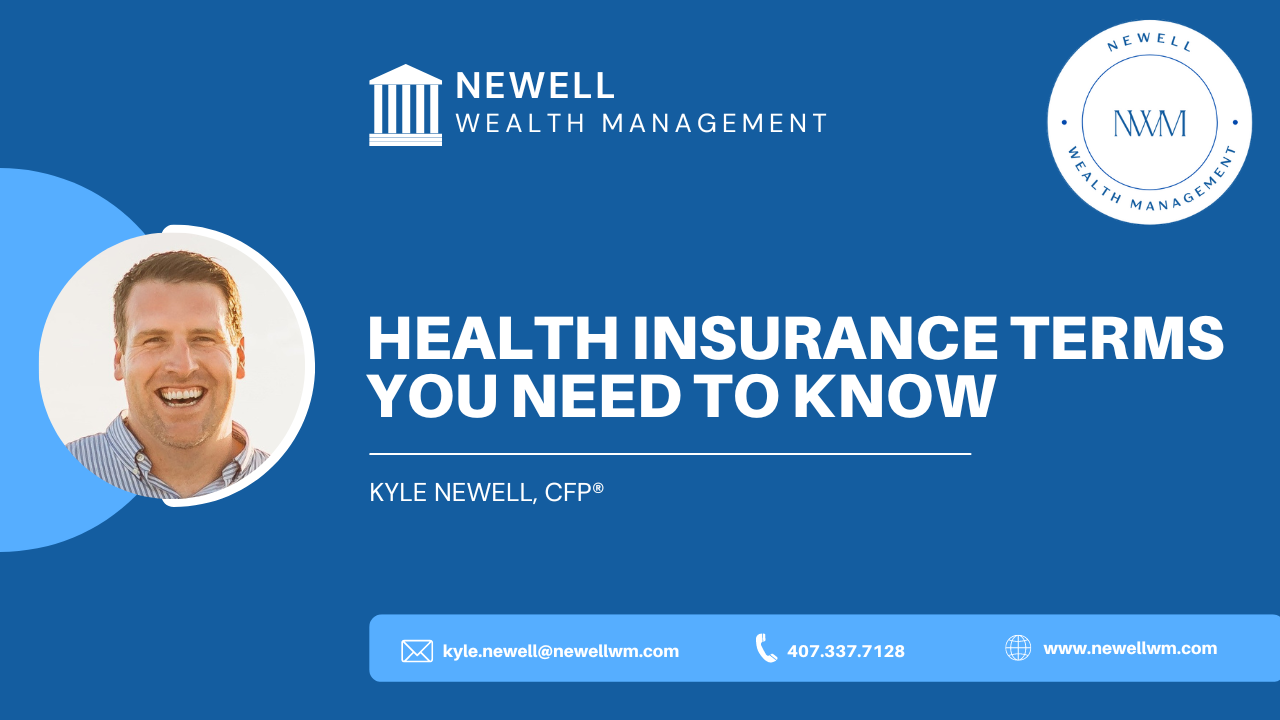Health Insurance Terms You Need to Know

My wife is a teacher. When she gets around her friends who are also teachers, the first thing they do is slip into “teacher talk.” They talk about reading scores, Kagan exercises, and other things that only teachers understand. I feel like a stranger in a strange land.
They know the lingo and can understand it because they’re insiders. To someone who is not as familiar with “teacher talk,” it makes it challenging to engage and add value to the conversation. Many industries have their own vocabulary, and health insurance is no exception.
Now is generally when companies have open enrollment for benefits. You may be looking at the options and trying to make decisions about what to choose. With all of the buzzwords and jargon in health insurance, many people have difficulty understanding certain abbreviations or terms. They may not understand how the different options apply to their specific situation, so they just try to make the best decision possible.
The process often involves talking to friends and family or just doing what their parents did when they were growing up. This approach doesn’t consider their own financial situation when making important decisions around health insurance. Let’s look at some primary keywords and abbreviations for health insurance, what they mean, and what they should look like in theory. Basic knowledge like this can help you think about your health insurance choices in the framework of your situation.

What do HMO and PPO mean?
Typically the first decision you need to make is what type of health insurance plan to choose. The main two are HMOs or PPOs. You’re probably wondering what those abbreviations mean and what’s the difference.
1) HMO (Health Maintenance Organization)
An HMO is, in essence, a closed network of providers. Every doctor you see, such as primary care doctors and specialists, is within this closed system known as your network. The benefit of that closed system is that it usually ends up being less costly to you. They’re less expensive by a deductible or by your ongoing monthly premium. Mainly because if you’re using one system, that hospital system can get the revenue from you for everything.
For example, if you go to your primary care doctor and your shoulder hurts, that doctor will send you to the orthopedic doctor. The orthopedic doctor will refer you to the surgeon, who sends you to the physical therapist, and so on. You pay for each visit in that network so the health insurance company basically rewards you for staying within that one system with better pricing.
2) PPO (Preferred Provider Organization)
A PPO means that your options are now more open regarding which doctors you can choose to go to that are still considered in-network. Maybe one hospital system has the best shoulder surgeon, but another hospital system has the best allergy specialist. Perhaps you have done your research and found one who is an expert in their field or has come highly recommended. Possibly you just like working with specific doctors and don’t want to change.
The PPO basically expands what your options are as far as doctors you can choose from that would still be considered in-network doctors. While you have more choices, benefits will pay out differently depending on whether you are in-network or out-of-network.

Other Key Terms
1) In-network
This word means those are providers that the insurance company has approved or has some sort of relationship with. They have already negotiated the costs of different things with this preferred provider within their network or HMO system.
This pre-existing relationship gives the medical provider a certain payout for the service and the insurance company a quicker means of processing and payment.
2) Out-of-network
If you choose to go out-of-network, the costs generally start to add up because out-of-network means that the provider doesn’t really have a relationship with the health insurance company per se. For this reason, they are going to possibly have to do some negotiating with the health care provider. It may end up being more costly for everybody, yourself included.
If you think about yourself as an insurance company, you know people are going to get sick or need surgeries, etc. If you can negotiate beforehand with the doctors and the hospitals, what the cost will be, that obviously helps the insurance company’s bottom line.
When talking about health, it’s a little odd to think about somebody’s bottom line. These are, however, still companies that, for the most part, are in business for profit. This is especially true for health insurance companies.
Some hospital systems are not for profit. There’s a saying I love that says, “They’re not for profit, but they’re also not for going out of business.” While they may be non-profit businesses, they still need to charge for services, pay wages, and do everything companies do.
3) Deductible
The deductible of the plan you are considering is essential to look at. It details how much you may have to pay out of pocket for expenses related to your health care. If you’re a reasonably healthy person who rarely goes to the doctor, you may be less concerned about your deductible. If you only go for your annual physical, usually those are covered by your health insurance.
If you’re a semi-healthy person or maybe have young children who tend to get sick, break bones, and get hurt in ways that young children do, the deductible becomes much more of a concern because of the associated cost.
In general terms, the deductible is the insurance company saying, “Hey, we’re going to cover you for any expenses that you might have. But we need you to pay up to this part.” They want you to pay up to the deductible because it potentially deters people from seeking medical care. When there’s some cost involved, and you don’t want to pay out-of-pocket, you may choose not to go to the doctor. Not going to the doctor can still be a costly thing to do. Whether you or the insurance company ends up paying for it, somebody still pays.
The intention is to drive behavior that deters people from going to the doctor for minor things, an expensive ER visit, or an out-of-network doctor. It drives behavior but also makes it a little easier for their numbers. This is why the deductible is usually higher. They know a $50 to $100 expense will be covered by the insured (you) rather than the insurance company.
There are some high-deductible plans where you pay for almost everything until you reach a much higher spending amount. An easy way to think of the deductible is that it is the amount you will pay out-of-pocket for healthcare visits. Generally speaking, HMOs and PPOs are the most common health insurance plans because of the in-network and out-of-network benefits.
4) Copay
You also often have a copay associated with a medical visit, even when you meet the deductible. Let’s say that your deductible is $500. You meet the $500, but you still have a 20% copay. The insurance company will pay 80%, and you will pay 20% until you reach your out-of-pocket maximum.
5) Out-of-pocket maximum
This is the total amount you pay out of pocket for any health care coverage for the year. It lasts for a one-year timeframe and resets again in January.
What to consider when choosing your plan
1) Can you afford the premium?
The premium is an ongoing expense to consider. How often you are paid may affect your ability to afford the premium of the plan you choose. Disney cast members are paid weekly. If you don’t work for Disney and are paid monthly or bi-weekly, can you afford the ongoing premium?
2) Do you have enough cash reserves to cover the deductible and out-of-pocket maximum?
If the worst case happens and you have an emergency that puts you in the hospital for a long time, it will be costly. You’re probably going to reach your out-of-pocket maximum.
For those who don’t have a healthy enough emergency reserve, maybe that steers you towards the lower deductible plans. You pay a little bit higher premium but know that you’re covered in the event of a health emergency. You can then try and work to get a higher deductible.
If you can, it’s nice to have an emergency fund to save for healthcare costs. It may be in the form of a health savings account or a flexible spending account. This way, you don’t have to be lining the insurance company’s pockets but hopefully lining your own.
I hope this helps explain some of the different variables associated with health insurance. There’s a lot more to it. While I didn’t cover every detail, the intent was to provide a high-level overview of the common themes.
Important Information
Newell Wealth Management, LLC (“NWM”) is a registered investment advisor offering advisory services in the State of FL and in other jurisdictions where exempted. Registration does not imply a certain level of skill or training. The presence of this website on the Internet shall not be directly or indirectly interpreted as a solicitation of investment advisory services to persons of another jurisdiction unless otherwise permitted by statute. Follow-up or individualized responses to consumers in a particular state by NWM in the rendering of personalized investment advice for compensation shall not be made without our first complying with jurisdiction requirements or pursuant an applicable state exemption.
All written content on this site is for information purposes only and is not intended to provide specific advice or recommendations for any individual. Opinions expressed herein are solely those of NWM, unless otherwise specifically cited. Kyle Newell and NWM are neither an attorney nor an accountant, and no portion of this website content should be interpreted as legal, accounting or tax advice. Material presented is believed to be from reliable sources and no representations are made by our firm as to other parties’ informational accuracy or completeness. There is no assurance that the views or strategies discussed are suitable for all investors or will yield positive outcomes. Investment involves risks including possible loss of principal and unless otherwise stated, are not guaranteed. Any economic forecasts set forth may not develop as predicted and are subject to change. All information or ideas provided should be discussed in detail with an advisor, accountant or legal counsel prior to implementation.
